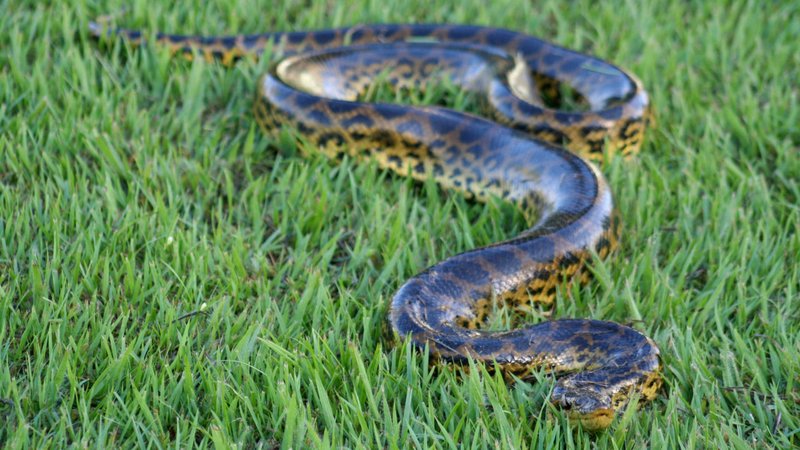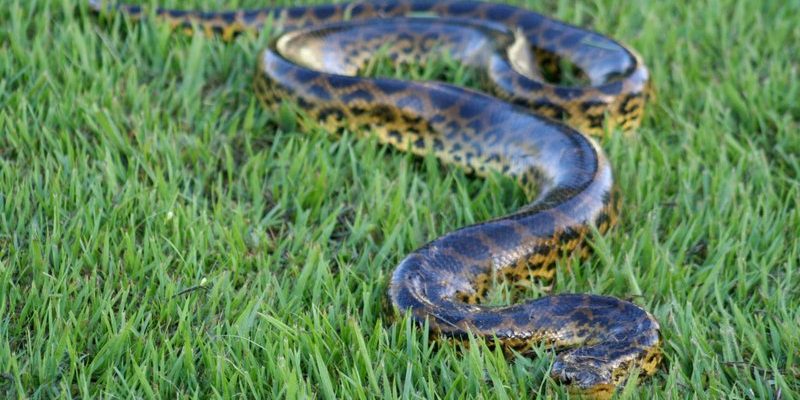
In this article, we’ll dive deep into the life of the green anaconda, exploring its behaviors, adaptations, and the vital roles it plays in its ecosystem. You might be surprised to learn just how interwoven these serpents are with their surroundings, almost like a thread in a beautifully intricate tapestry. Let’s take this journey together and unravel the secrets of this fascinating creature!
Habitat of the Green Anaconda
The green anaconda, one of the largest snakes in the world, thrives primarily in swampy areas, marshes, and slow-moving streams of South America. Countries like Brazil, Colombia, and Venezuela provide a rich environment where humidity and lush vegetation reign. Think of a giant, green jungle gym where anacondas can slither, swim, and hide easily from both prey and predators.
These snakes prefer locations with plenty of cover. This means they often seek out dense vegetation, allowing them to blend in seamlessly with the surrounding flora. This natural camouflaging not only helps them stay hidden from potential threats but also aids in their hunting techniques. It’s like wearing a cloak of leaves and shadows, making them nearly invisible while they wait for the perfect moment to strike.
Another crucial aspect of their habitat is water availability. Anacondas spend a significant amount of time in the water—a fact that may surprise those unfamiliar with snakes. These semi-aquatic giants use water not just for hunting but also for regulating their body temperature. When a sunny day rolls around, you might find one basking on a warm rock, cooling off in the water, or floating lazily through the current.
Diet and Hunting Techniques
You might be wondering, what does the green anaconda eat? The answer is, well, just about anything it can fit in its mouth! These snakes have a fascinating diet that includes fish, birds, small mammals, and even large prey like capybaras and deer. Their size and ability to constrict their prey make them formidable hunters.
Anacondas rely heavily on their ambush technique for hunting. Imagine sitting in a cozy café, sipping your preferred drink, waiting for your friend to arrive. That’s exactly how an anaconda operates—but instead of coffee, it’s waiting for a meal. They’ll often stay coiled around tree trunks or nestled in the shallow waters, patiently waiting for unsuspecting prey to wander too close. When the moment is just right, they’ll strike with incredible speed, wrapping around their victim in a powerful grip.
Once they’ve captured their prey, green anacondas are experts at constriction. They squeeze their prey until it can no longer breathe, then they swallow it whole. You might think that sounds gruesome, but it’s all part of the cycle of life in the wild. This unique way of hunting is essential for maintaining the balance within their ecosystem, controlling populations of various species and ensuring a healthy habitat.
Role in the Ecosystem
The green anaconda plays a vital role in its ecosystem. As a top predator, it helps regulate populations of animals in its environment. By keeping numbers of certain species in check, it prevents overpopulation, which can lead to depletion of resources like food and shelter. Think of it as a balancing act, ensuring that no one group becomes too dominant.
Moreover, these snakes influence the biodiversity of their habitat. By preying on various animals, they help sustain a variety of species. This interaction fosters a healthy ecosystem where plants and animals can thrive, each relying on the other in a delicate dance of life. Without predators like the green anaconda, certain species could become too numerous, potentially disrupting the entire woodland and wetland systems.
When green anacondas consume prey, they also contribute to the nutrient cycle. As they break down food, nutrients are released back into the soil, enriching their surroundings. This process benefits not only plants but also the animals that feed on them. It’s a classic case of give-and-take, where each organism plays a part in maintaining the health of the ecosystem.
Threats to the Green Anaconda
Despite their impressive size and hunting skills, green anacondas face several threats in their natural habitat. One of the most significant dangers is habitat loss due to deforestation and climate change. As humans encroach on their territories, these snakes find their homes disappearing, leaving them vulnerable.
Additionally, they are sometimes hunted for their skins, which are highly valued in the fashion industry. This illegal trade further threatens their population. Imagine living in a place where your home is constantly shrinking, and you have to worry about being chased for your unique wardrobe. That’s a reality for many green anacondas today.
Pollution is another serious issue. Runoff from farming and urban areas can contaminate the waters where anacondas typically hunt and live. This pollution can affect their health and the health of their prey, creating a ripple effect in the ecosystem. As we continue to change our environment, it’s crucial to remember the impact on all life forms—even those as mighty as the green anaconda.
Conservation Efforts
To protect the green anaconda and its habitat, various conservation efforts are underway. Protected areas and national parks are some of the most effective means to safeguard their environment. By establishing these safe havens, we allow green anacondas to thrive and support a diverse ecosystem.
Additionally, raising public awareness about the importance of these snakes is essential. Educating communities about the ecological roles of green anacondas helps foster respect and understanding, which can lead to more significant conservation efforts. It’s about shifting perceptions, helping people realize that every creature, no matter how intimidating it may seem, has a place and purpose.
Organizations are also working towards regulations that limit hunting and trade of green anacondas. By enforcing laws that protect these snakes, we can reduce the pressure on their populations. After all, it’s not just about saving one species; it’s about maintaining a healthy and balanced environment for everyone.
The green anaconda isn’t just a large snake; it’s a crucial player in its ecosystem. From regulating populations of prey to enriching the soil, this snake is an integral part of the delicate balance of life in the wetlands and jungles of South America. As we learn more about the role of the green anaconda, it becomes clear that protecting their habitat is not just beneficial for them but essential for the health of the entire ecosystem.
By understanding their significance, we can take steps toward conservation and create a future where the beauty of the green anaconda continues to thrive. Remember, every creature, big or small, has a role to play in the grand story of life unfolding all around us. Let’s do our part to ensure that this story doesn’t come to an end.

